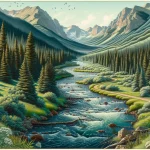From the geologic marvels of the Mancos Shale formation to the many outdoor recreational activities, the East Mancos River provides unique experiences for thrill-seekers, families, and inquisitive travelers alike.
In This Article
The East Mancos River beckons visitors with its captivating blend of geological wonders, historical significance, cultural charm, and sustainable tourism opportunities. Outdoor adventurers, history aficionados, and nature lovers alike will find something extraordinary in this pristine natural setting.
TL;DR
- East Mancos River is located in southwest Colorado and is known for its scenic landscape and wealth of outdoor recreational activities.
- The Mancos Shale formation plays a major role in the area's geology, including features like the Mancos "B" fluvial deltaic facies.
- Historically, the East Mancos River was inhabited by ancient Puebloan people and shaped by early settlers and developments like irrigation and mining.
- Visitors can enjoy activities like hiking, fishing, wildlife viewing as well as learning about Ute Indian history.
Located in the picturesque San Juan Mountains of southwestern Colorado, the East Mancos River meanders through Montezuma County, offering a tranquil retreat for outdoor enthusiasts. It is a tributary of the San Juan River (a larger tributary of the Colorado River). Renowned for its stunning mountain vistas and crystal-clear waters, this river merges with the Mancos River near the charming town of Mancos.
Outdoor aficionados flock to the East Mancos River for its abundant recreational opportunities, including fishing, hiking, and camping. Accessible through forest roads and scenic hiking trails in the encompassing national forests like the San Juan National Forest and the Rio Grande National Forest, the East Mancos River invites visitors to immerse themselves in nature’s splendor.
The Allure of the Landscape
The landscape surrounding the East Mancos River is defined by the unique geological formations that shape the terrain. Most notable is the widespread Mancos Shale, a marine formation laid down in the Late Cretaceous period around 70-75 million years ago. Comprised of dark gray silty shale and siltstone layers, the Mancos Shale contains sandstone, limestone, and bentonite beds that provide clues into the ancient shoreline environment in which it formed in.
As the shale came into contact with igneous intrusions, it transformed into a metamorphic rock called hornfels, gaining a harder, more crystalline structure. This variable metamorphism across the Mancos Shale influences the chemical weathering behaviors that impact water quality in the region.
The Mancos Shale also has economic significance as an unconventional oil and gas reservoir, where hydraulic fracturing and horizontal drilling tap into its hydrocarbon resources. The Mancos “B” bed is one fluvial deltaic facies that has proven to be a particularly productive zone for oil and gas production.
Sitting atop the Mancos Formation across much of southwest Colorado is the Mesa Verde Group, a series of sandstones, shales, and coals that fill an eastward regressive sequence as shorelines retreat. These layers tell a story of rising and falling sea levels across the area over millions of years.
Tracing the History
The East Mancos River’s human history is closely tied to the Ute Indian tribes that have inhabited southwest Colorado for centuries. Petroglyphs and archaeological sites scattered across the area provide glimpses into the lives of the Ute people and other ancient Puebloan cultures.
The river itself is fed by snowmelt from the La Plata Mountains, carving out the valley with its eroding power to shape the dramatic canyon landscapes. The town of Mancos was established in 1894 to support the irrigation and farming industry that grew around tapping the river’s resources.
Ranchers and miners alike settled in the region to tap into its rangelands and mineral riches. Coal mining drove the local economy in the early 20th century and still continues in the area today. The East Mancos River’s journey has been intertwined with the people seeking to harness its life-giving yet sometimes destructive forces, leaving an indelible imprint on the land.
Immersing in Local Charm
A unique highlight of East Mancos River is the chance to immerse yourself in local Ute Indian culture through festivals, museums, and tribal parklands. The Ute Mountain Tribal Park provides an opportunity to see well-preserved ancestral Puebloan cliff dwellings and petroglyphs accompanied by Ute guides.
The town of Mancos hosts a variety of community events celebrating the region’s cultural heritage, such as the Ute Mountain Roundup Rodeo and the Mancos Days festivities. Visitors can explore the local creative spirit through shops featuring artisans specializing in Ute mountain art and handcrafted goods.
For a memorable meal, be sure to try one of the family-run Mexican restaurants in Mancos or ask locals where to find the best authentic frybread. From the artwork to the time-honored recipes, immersing yourself in the local culture will provide eye-opening insight into the community’s values.
Adventure Awaits
From hiking to fishing to wildlife viewing, East Mancos River offers abundant opportunities for outdoor recreation. The temperate climate provides plenty of comfortable days to explore the outdoors. Families can enjoy easy hikes and picnic areas along the Mancos River, while avid cyclists and equestrians can take on more challenging mountain trails.
In the winter, the area transforms into a veritable wonderland, with cross-country skiing trails cutting through snow-blanketed forests. Ice climbers test their skills on frozen waterfalls as backcountry skiers and snowshoers explore off the beaten path.
Fishing is a popular pastime on the East Mancos River, where anglers reel in native cutthroat and rainbow trout from the cold mountain waters. Wildlife enthusiasts may spot elk, mule deer, black bears, mountain lions, and over 200 species of birds inhabiting the diverse montane habitats.
While outdoor recreational activities abound, it’s important for visitors to follow responsible tourism practices that preserve East Mancos River’s natural heritage. Staying on marked trails, properly disposing waste, avoiding wildlife disturbances and minimizing campfire impacts allows both visitors and future generations to enjoy these lands.
Preserving the Watershed
As a life source for the region’s plant and animal habitats, the East Mancos River watershed is a precious resource that conservation efforts aim to maintain. Groups like the Mancos Conservation District work to improve irrigation infrastructure and promote soil health on agricultural lands that make up much of the watershed.
Ongoing monitoring and research seek to understand the impacts of activities like mining and agriculture on water quality. One recent study analyzed solute release rates across different metamorphic grades of Mancos Shale to determine the shale’s impact on salinity and trace metals entering the watershed’s streams.
Tourists can do their part by respecting trail closure or fire restrictions, keeping vehicles on designated roads, and avoiding river access in sensitive or erosive areas. Following Leave No Trace ethics on public lands also helps preserve habitats and minimize human impacts.
Planning Your Visit
Visiting East Mancos River is an easy day trip from nearby towns like Durango or Cortez in Colorado. While offering remote wilderness and quiet valleys, it also provides some basic amenities for travelers. The town of Mancos has a variety of hotel options, campgrounds, and RV parks, as well as restaurants and shops with local artisan wares.
The best time to visit depends on the types of activities you want to experience. Summer offers mild weather perfect for boating, fishing, hiking, and cultural events. Fall lures visitors with dazzling golden Aspen displays, while winter activities like skiing and snowshoeing become popular when snow blankets the mountain landscapes.
No matter the season, spectacular scenery and cultural heritage await those who venture out to uncover East Mancos River’s natural allures. However, through responsible tourism, visitors play a critical role in protecting the waters, lands, and communities that make this hidden gem so precious.
FAQ
How long have people been living in the East Mancos River area?
The East Mancos River area has been inhabited for over 2,000 years, with ancestral Puebloan peoples and Ute Indian tribes calling it home and leaving behind artifacts like cliff dwellings and petroglyphs.
What is there to do in the winter around East Mancos River?
Popular winter activities include cross-country skiing, snowshoeing, ice climbing, and backcountry skiing. The snow-covered mountain scenery creates a magical wonderland to explore.
Where does the name “Mancos” come from?
The name “Mancos” is Spanish for “crippled” or “mutilated,” referring to an early settler who lost his arm in a fight with Ute tribes resisting their land being taken.
How can I learn more about Ute Indian culture?
Visitors can tour sites like the Ute Mountain Tribal Park with Ute guides to see ancestral homes and rock art, as well as attend cultural events like the Ute Mountain Roundup Rodeo to celebrate traditions.
What is the best way to get to Mancos, Colorado?
Mancos is located near the intersections of Highway 160 and Highway 184, approximately 30 minutes west of Durango and 40 minutes east of Cortez. It’s most easily accessible by road trip.






